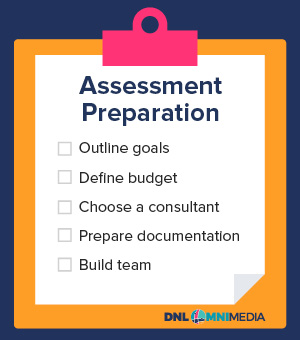Hilary is the Digital Fundraising Manager at DNL OmniMedia. For over a decade, she’s brought fundraising strategy & technology together to create successful campaigns. Hilary specializes in technology audits, digital fundraising, and technology implementations.
Consider the evolution of nonprofit tech over the past year and a half. When the pandemic hit, you probably invested in video conferencing tools as your nonprofit’s team headed home to work safely. This was likely followed by testing out one or two project management systems as you tried to find a work-from-home solution that served your nonprofit well.
At the same time, you incorporated additional online and virtual fundraising tools to continue raising funds as in-person events pivoted to virtual seemingly overnight. And now, you’re using a hybrid fundraising model to address both in-person and online engagement— and you likely have new software to address that change as well.
You’ve probably invested in so many nonprofit technology solutions in the past year that you don’t know which you still have access to and which you don’t. In addition, your nonprofit is focused on year-end giving from now through December. But what about setting your organization up for nonprofit tech success in the new year?
A nonprofit technology assessment gives your team a full inventory of your current nonprofit software suite, how systems are integrated, and improvements for more success in the new year. In this guide, DNL OmniMedia will cover the ins and outs of conducting a nonprofit technology assessment from start to finish through the following points:
- Preparing for the Assessment
- Conducting a Technology Assessment
- Step 1: Discovery
- Step 2: Analysis and Strategy
- Step 3: Documentation
- Step 4: Review
The guide below provides a reasonably comprehensive look at conducting a nonprofit technology assessment for your organization. You can also check out DNL OmniMedia’s guide to explore the topic in depth.
With that, let’s get started!

You’ve decided to lead your organization through a technology assessment. Before you partner with a nonprofit tech consultant, complete the following steps to ensure your team is well-prepared for the evaluation. Doing this now will save money in the future:
- Outline your goals for the effort. There are a few different goals that you may have walking into this assessment—whether simply mapping out an inventory of your tech, solving for a specific pain point, or innovating your nonprofit’s software to stand out from the crowd. Figure out what drives your organization before you begin the assessment.
- Define your budget for both the assessment and any follow-up activities. This budget should include the cost of the assessment itself, such as any consulting fees, as well as the cost of investing in software optimizations (new software, data hygiene efforts, etc.). Don’t worry if this is a broad range – it will become more defined later.
- Choose a consulting partner to conduct the assessment. There are a variety of nonprofit consulting firms on the market. This DNL OmniMedia list has several strong contenders. Choose a technology-specific firm to conduct your assessment.
- Prepare any initial documentation for your nonprofit consulting partner. Are there any pressing roadblocks that you continue encountering technology-wise? Any technology for nonprofits that you’re interested in implementing? Do you have an inventory of your current systems and how they are related to one another? Prepare any initial inquiries for your technology consultant to ensure you cover all pressing questions.
- Build your team. Identify a cross-departmental team to lead the assessment. If your nonprofit has an internal information technology (IT) team, that team can lead the project.
Once you’ve completed your pre-work, dive into the assessment process with your nonprofit consulting partner.

Conducting a nonprofit technology assessment can take anywhere from 6 to 12 weeks. This covers the examination alone and any ongoing implementations or updates may extend beyond this timeline.

Your technology assessment will begin with a discovery phase, during which your consulting partner meets with your nonprofit’s leadership team to develop an understanding of your organization’s goals and current technology use.
During this phase, the consultant seeks to understand:
- Who your organization is. What are your guiding principles? What is your nonprofit’s mission, and what activities do you complete throughout the year to advance it?
- Why you’re conducting the assessment. Are you preparing for a capital campaign and looking to ensure your software solutions are up to par? Have you noticed that your technology suite is outdated and holding your organization back?
- What your goals are for the assessment. What does your “dream state” look like, as far as your technology suite after the evaluation is completed?
- What your current understanding of technology is. What solutions currently make up your technology stack? What level of technology literacy exists across your team?
This step sets clear parameters for your nonprofit technology assessment and ensures both your organization and consulting partner are working from the same foundation.

This is when your consultant steps in to both analyze your nonprofit’s technology stack and create a strategy for optimizing it to reach your nonprofit’s goals.
Starting with analysis, your consultant will deploy internal team surveys to understand your current nonprofit software use. This includes:
- The solutions you’re using, such as any tools used for fundraising, stewardship, constituent relationship management, and even working from home.
- Why you’re using the solutions, such as video conferencing software for virtual fundraising.
- How these solutions are (or, are not), working for your organization, such as whether they’re adequately mobile accessible or not.
This information is then used to create a full digital strategy for improving your nonprofit’s technology suite. This will include recommendations such as:
- The software solutions to invest in/divest from
- Areas where software can be improved (unclean data, ineffective donation forms, etc.)
- Policies to implement to ensure your team uses technology effectively
- Recommendations for any staff training
This strategy is what will align your software suite with the goals you outlined in the first step of the technology assessment process.

The technology consultant will then document all of their findings. This documentation will cover a range of information, including:
- An inventory of all existing solutions
- Any recommended optimizations
- A roadmap for the implementation of those optimizations
- Any products or customizations that will be created or purchased as part of the optimizations
- The goals that will be achieved with the roadmap
This assessment will give you an in-depth look at the current state of your nonprofit’s technology, as well as a path forward should you choose to continue working with the nonprofit technology consultant.

Lastly, your nonprofit technology consultant will review the documentation with you and provide your nonprofit with options for the next steps. Generally, this includes:
- Working with the consultant to carry out the optimization roadmap. The consultant will provide your nonprofit with a quote should you choose to work with them to improve your tech.
- Working with another consultant to carry out the updates. You can explore the market of nonprofit technology consultants if you feel that there may be a better fit for your organization.
- Handling the implementation internally. If you have an experienced internal technology team, you may implement some of the optimizations independently. However, most organizations choose to work with a nonprofit technology consultant at this stage, especially those who use more comprehensive CRM and fundraising solutions.
One of the reasons that many nonprofits choose to work with a nonprofit technology consultant to carry out these optimizations is that consultants offer a wide variety of services to improve your nonprofit’s software. You can access a host of services including:
- Nonprofit website development
- CRM and data management
- Fundraising solution optimization
- Marketing solution optimization
- Advocacy solution optimization
- Mobile app development
Working with the same consultant who conducted your assessment to carry out the optimizations has the additional benefit of saving time. You can gather additional quotes, but this takes time and slows down your optimizations. The consultant who conducted your assessment can hit the ground running and begin aligning your technology stack with your goals as soon as the assessment is complete.
A nonprofit technology assessment is an invaluable initiative when it comes to setting your nonprofit up for success in the new year. This is especially true considering the radical changes that your technology stack likely underwent in the past year and a half!
Begin your technology assessment process by outlining your goals and budget. Then, once you’ve chosen a nonprofit technology consultant, that partner will handle the rest!
Need some help with your nonprofit tech? Check out these resources:
- Optimizing Your Software: 4 Tips for Growing Nonprofits – DNL OmniMedia, Inc.
- Donation Software for Nonprofits | Essential Tools for 2019 (qgiv.com)
- Nonprofit Technology: Why, What & How of Smarter Fundraising – DNL OmniMedia, Inc.
About DNL Omnimedia, Inc.
We value relationships and are proud to connect nonprofits to our partner network and hope this helps increase your nonprofit’s effectiveness and success. We proudly partner with DNL Omnimedia, Inc., specializes in nonprofit software, data migrations, and analytics.





